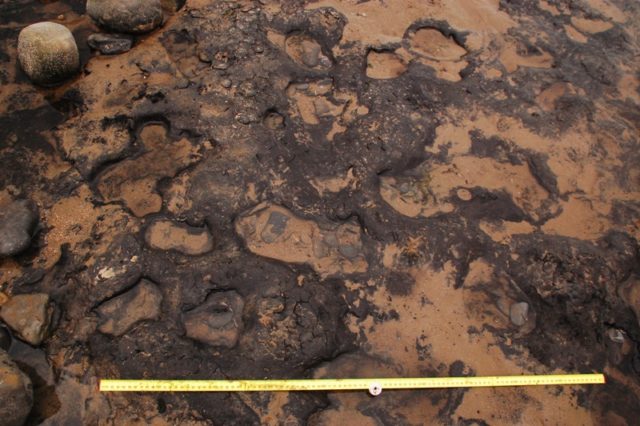On the Welsh coastline, fragile human footprints made initially in freshwater marshland have been discovered. These were first thought to be from the Bronze Age, but with a new study carried out on them, scientists have learned they are actually 3,000 years older than previously thought.
The footprints were possibly made by a hunting party that included children; both adult and child footprints were found at the site. The prints were discovered in 2014, at Port Eynon on the Gower peninsula in South Wales.

New dating techniques put the group of prints in the Mesolithic period, a time when humans were mainly hunters and gatherers. Radiocarbon dating was carried out by Ph.D. student Rhiannon Philp at Cardiff University. She was excited to see that her dating showed the fragile footprints to be even older than first thought. There are five prints in total – two of them point to the sea and the others face inland. There are more than just human prints preserved in the marshlands; there are also prints of deer and wild boar, all traveling in the same direction as the group of humans.
Post-Ice Age footprints are very rarely found; only nine have ever been located and most of these were discovered in Wales. The areas in which they are found tend to have been marshy, boggy lands that were later lost under the rising sea level.
Due to climate change and the fragile nature of the samples, their research is given priority, as they could be quickly lost to environmental factors. As it is, the prints can be seen only during low tide.

The Gower coast is a good place to find ancient discoveries, and many interesting things have been found there over the years.
It is one of the Welsh areas believed to have been occupied before the last Ice Age ended, and evidence of that occupation is still there to be discovered. Paviland Cave in Gower, discovered in 1823, contains the earliest evidence of modern man.
Read another story from us: The discovery of the submerged “Stone Age Atlantis”
A Mesolithic settlement was found on Burry Holmes back in 1919. Across Gower, there are still cairns being found that are from both the Neolithic and Bronze Ages. The most famous of all the sites discovered in Gower is a place called “Arthur’s Stone”, or Cefn Bryn, which is a burial tomb from the Neolithic Age that has been dated back to 2500 BC.
